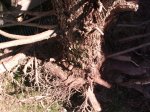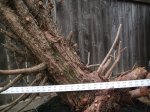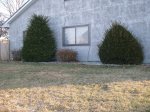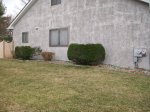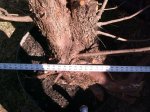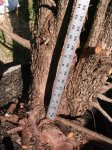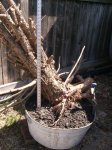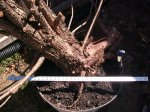Agree Brian. I lost those two gorgeous yews last winter after removing them from dense soil, putting it in turface/lava/pumice and cut off too much green. So if it's really nice material, I'd rather be safe than sorry.
Sorry to hear that Chris. I'm on my fourth or fifth year of working on collected yews and can share a little more of my experience. Of the six that were dug, I still have four. One of the ones that didn't make it was collected from a very dry/rocky yard, and I wasn't able to get many roots - after hitting it with my lawn mower in the middle of the summer it fell out of the pot and shortly thereafter croaked. The other died more recently as noted below.
After digging the yews, that spring I worked the rootballs hard, getting out as much of the field soil (mostly heavy red clay for most of the ones I dug) as possible, and put the trees in an inorganic mix. I kept as many fine feeder roots as possible to put the tree into a decent sized container. I also cut the tops back quite a bit, leaving a good 6-12 inches of extra material for what I thought would be the final image. That helped me to keep extra foliage on the tree, as well as have extra material to work into deadwood or otherwise cut back if there was dieback.
A year or two later, I found on the next repot that the yews had put out an incredible amount of fine feeder roots, and abandoned most of the larger original roots. That helped me to put the trees into an even smaller container, as I was able to cut off the larger roots that were abandoned.
Aside from the root growth, the foliage growth the first year after collection was very strong. However, I found that the foliage growth generally slowed pretty dramatically in the second and third years, even with all the new fine feeder roots. The root balls also didn't grow all that much more from that first year as well. My sense is that the yews have a lot of stored energy to help them through the first year, then they are pretty depleted after. The smaller yews that I dug were fine, but two of my larger yews appeared to suffer more. One of my larger yews didn't make it after the 2013-2014 rough winter we had (probably because it was weaker than I thought). My other one seems to be doing ok, but I went ahead and planted it in the ground to hopefully get it stronger. It was in an Anderson flat, but the container seemed to be staying too wet so hopefully the ground helps. Even three or four years after collection, the root ball had not appreciatively increased from where the rootball was a year after collection.
So my sense is that you can work the rootballs and tops pretty hard on collection, just keep as much foliage and roots as possible. You might get strong root and foliage growth that first year after collection, but don't let that give you false confidence in the strength of the tree as they seem to slow down significantly in years 2 and 3. I would work them hard, get them into the smallest containers you can, and then not touch them for a good 2-3 years, especially if they are on the larger side. If I had to guess, I think the mistake made by the guy in the Hans van Meer blog was that he started working the tree too hard right after collection, and didn't give the tree a chance to recuperate. I saw the tree in person and it was a gorgeous tree too - too bad.
For what it's worth, I think this principle also applies to old collected boxwoods as well. Don't let the foliage and root growth after the first year of collection fool you - the trees are probably a lot weaker with energy stores depleted than you think.


